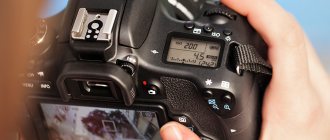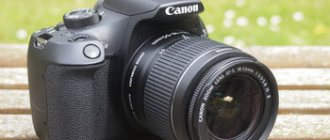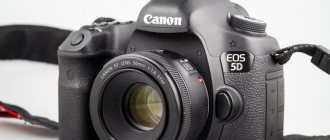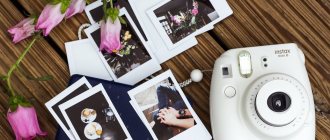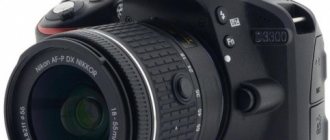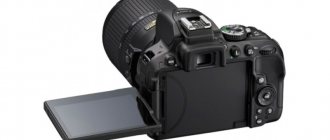| Place | Name | Characteristics in the rating |
| The best compact (digital) cameras for shooting video |
| 1 | Canon PowerShot SX540HS | Light weight. Ergonomic body |
| 2 | Panasonic Lumix DC-FZ82 | Record 4K video in excellent quality. Optical 60x zoom |
| 3 | Fujifilm FinePix XP140 | The lowest price. Better case protection. Possibility to take photos and shoot videos underwater |
| The best DSLR cameras with good video |
| 1 | Canon EOS 5D Mark IV Body | Simultaneous work with two memory cards. LiveView with auto focus |
| 2 | Nikon D7200 Kit | Housing with dust and moisture protection. Battery 1900 mAh for 1000 photos |
| 3 | Canon EOS 800D Kit | The best camera for beginners |
| 4 | Nikon D3500 Kit | Optimal price-function ratio |
| The Best Mirrorless Cameras for Video Shooting |
| 1 | Olympus OM-D E-M1 Mark II Kit | Powerful electronic stabilization for video shooting. The most reliable |
| 2 | Fujifilm X-T3 Body | Sync contact for external flash. Headphone output |
| 3 | Sony Alpha ILCE-6000 Kit | High-quality 3D shooting and HD video interface |
Protected "compacts"
Olympus Tough TG-6
A rugged camera that doesn't compromise on functionality. Photo: fotosklad.ru
Price: from 29 thousand rubles.
The Olympus TG-6 continues the company's tradition of creating the best rugged cameras on the market. The TG-6 is waterproof to 15 meters (without the use of any additional accessories), drop protection up to 2.1 meters, as well as frost and dust resistance.
But unlike many rugged smartphones, which sacrifice most other features for high levels of protection, the TG-6 produces high-quality photos with RAW support and 4K/30p video. This model has an excellent battery life (340 shots on one charge). The camera has a range of macro and underwater shooting modes, and there are plenty of interesting accessories available.
Downsides include a rear screen that scratches easily (which is odd for a model like this), lack of Bluetooth, and a slightly confusing menu system.
Fujifilm FinePix XP140
Budget camera with good protection performance. Photo: fotosklad.ru
Price: from 13 thousand rubles.
A more budget model in the rugged category is the Fujifilm FinePix XP140. This is a version of the simplest compact camera, which is not scary to give to a child (it is not easy to break the FinePix XP140 - it is protected from falls from a height of 1.8 m) or dropped into the sea while on vacation (waterproof up to 25 meters).
For its price, the FinePix XP140 has passable autofocus, but you shouldn’t expect outstanding photos from it: the image quality is at the level of mid-budget smartphones. 4K video is limited to 15 fps, but Full HD is already available at 60 fps. The zoom range is good (28-140mm), but the lens is quite dark (f/3.5-5.5), so the quality of images deteriorates sharply in low light. The camera can take 240 photos on a single battery charge, significantly inferior to the Olympus TG-6 in this characteristic.
* When preparing the article, materials from the resources dpreview.com and onfoto.ru were used
BLOG OF DMITRY EVTIFEEV
Hello, friends!
In this article, I will not study the newest and most expensive cameras that can shoot video, but will approach the issue more pragmatically and share my personal experience in selecting a camera for video shooting for several genres. I want to say in advance that I don’t consider myself a guru in the field of video shooting, I’m just trying to develop and if anyone is also interested, then I share my experience.
Content:
- Cameras for interviews
- Real estate cameras
- Vlogging cameras
- Results
I do video filming of business interviews (example 1, example 2) and photo/video filming of real estate (mostly luxury).
Since my friend Rostislav and I started by filming interviews, it so happened that we used our own cameras, which were sufficient for these purposes, and then I already carried out some research.
All conclusions in this article are subjective, you can have your own opinion and experience, I will be glad if you share it in the comments.
So, you don't need autofocus to shoot interviews. It's not needed at all. The camera is adjusted to focus before shooting and then you shoot as much as the camera allows. The problem here is that you need three cameras to shoot:
1. camera for the presenter 2. camera for the interviewee 3. general camera
At the beginning we had two Canon ( Canon 5DsR and Canon 5D mark III ), and the third camera (general plan) was constantly changing and experimenting. From what I understand for myself, all cameras must be of the same brand, otherwise color processing becomes non-trivial and only a very experienced colorist can bring the cameras “to the same denominator.”
color profile FUJI X-H1
In the photo, the director of the Vuoksa company is Anatoly Pavlovich Fedorov, which produces wobblers for fishing, whom we interviewed.
Some of the light comes from bad fluorescent lamps, and FUJIFILM strongly dislikes this spectrum and therefore the skin color is purple.
The Canon color profile copes better in such situations because... It contains quite a lot of “red” skin tones.
Canon color profile (5d mark IV, 5DsR, 5D mark III, 650D - the same everywhere)
Here I am “distorting” a little because... This is a shot from a different shoot, but in the original article there is an example from Canon from the same scene, it’s less noticeable, but there is a big difference. The very fact that Canon prefers “red” tones, and almost all cameras (SONY, FUJI, PENTAX, etc.) on a SONY are purple is a fact.
SONY A7R III and backup action camera
This is also noticeable when filming at various industrial sites where, on cameras with SONY , my walls were partially purple instead of gray.
The entire wall is the same color - gray and white (shot on FUJIFILM X-H1).
The lighting in factories is terrible, with poor fluorescent lamps, apparently the sensor manufacturer did not count on this. Canon 's isn't perfect either, but it's better.
When you try to use autofocus in an interview, the person being photographed close-up can easily fall out of focus, the camera will start looking for him and the focus will completely go out of focus. Because not everyone knows the peculiarities of shooting, that it is undesirable to lean back, forward and generally move greatly in the frame.
Losing focus occurs, in particular, because the aperture is usually not very tight (usually f5.6). On the one hand, to set a very closed aperture you need a lot of light, i.e. LED sources are 200 W each, and on the other hand, powerful constant light blinds those you are filming. It is not always possible to place a light source so that it is out of the field of view of the person you are filming and does not blind him. And plus the “volume” of the frame is lost because the background becomes as sharp as the foreground.
Shooting can be done in both FullHD and 4K at 25 fps. When shooting in 4K, we get the additional advantage of digital zoom without losing detail, but on Canon such shooting immediately results in huge files that are difficult to edit. I looked at Canon 80D or Canon 90D for this purpose because... they have all the advantages of the same Canon 5D mark IV , but you can also buy Canon Power Zoom Adapter PZ-E1 , which allows you to smoothly zoom with a button, like on a camcorder.
A point that camera manufacturers prefer not to emphasize is the duration of one video fragment, and it is very short in almost all cameras and is in most cases 30 minutes. This applies to most Canon , Sony , Fujifilm . This duration is not enough for an interview because... the interview always lasts longer (two hours), and if the interviewee is stopped, then it is difficult for him to return to the same emotional wavelength. But so far, of the cameras that I know, only the FUJIFILM GFX100 (impressions from using the GFX100) and action cameras take longer to write. Both are not very suitable for filming interviews. On the FUJIFILM GFX100, it’s a bit expensive to assemble an interview system consisting of three cameras with lenses, and the action cameras are not pleased with the video quality.
GoPro hero 7 black and Xiaomi Yi 4K+ were filmed simultaneously, the quality is approximately the same
In conditions when there is little light, action cameras make a lot of “noise” and clean their images using “noise reduction”, as a result, detail drops significantly. And their dynamic range is already small, so often some individual elements are overexposed. I’m generally silent about color. It's better to shoot in a neutral color profile and then paint it, rather than shooting in a standard one.
neutral profile on action camera
A similar description and comparison of the GoPro hero 7 black and Xiaomi Yi 4K+ action cameras is in this article. They are perfect for their tasks, but not for indoor shooting; the limitation is the not very good and small sensor.
action camera as a video recorder
Below is an example of the same shooting, but on a SONY A7R III - the difference in dynamic range and detail is obvious (despite the fact that an action camera is also 4K, but 4K can vary in detail).
SONY A7R III under the same lighting
Real estate photography today consists of three parts:
1. shooting a photo 2. shooting a video 3. shooting with a drone
We are now interested in shooting video, this is the topic of the article. An important point for shooting is again a good color profile. In fact, I don’t know for sure whether the client sees the difference, but I see it very clearly and that’s why I chose Canon .
The downside if you choose Canon is that there are few settings for video if we talk about Canon 5D mark IV or Canon 80D .
Canon 80D
The 4K bitrate on the Canon 5D mark IV is very high (500 Mbps) and therefore the files are large, although the quality is generally better than that of other brands where the bitrate is usually 100-200 Mbps. Also, 4K video is shot with a crop factor, from the central part of the matrix. The Canon 5D mark IV has a built-in LCD screen, which is inconvenient for tracking where focus falls, but this is overcome by an external screen installed in the hot shoe.
The advantages of the Canon 5D mark IV are its good color profile, the presence of 4K as such, and Dual Pixel AF . But the availability of 4K for real estate photography is not very relevant because... the files turn out to be very large, difficult to process, and at the end of the day, agents need a light file that takes up to 10 minutes. Autofocus is not usually used in real estate videography because... you move and it will catch arbitrary objects in the frame, it’s easier to set manual focus to a certain distance on a wide-angle lens (11-17 mm focal length on a full-frame camera) and then most of the room will be in focus.
We do not shoot in LOG format, like many others, because... this only slows down processing, which is already quite complex.
FUJIFILM X-H1, shooting in F-log
standard profile (not LOG)
It is enough for something to be slightly visible through the windows and to lighten the shadows if there are any, but in general it is better to shoot in cloudy weather so that the exposure difference is not so great.
For real estate photography, it’s a good idea to have 50 fps on your camera for FullHD resolution in order to then re-encode 25 and thereby get smoother video when slowed down.
Conclusion : 4K is not necessary. The fact that some cameras have a 4K crop is not scary because... Everything is filmed in FullHD. Shooting in LOG is not necessary for real estate photography, it is a waste of time. The problem with Canon cameras with high bitrates concerns only 4K, but in FullHD they have a completely normal bitrate of 80-200 Mbit/sec and shoot without cropping.
Alternatives
Considering the low requirements described above, there are many options. Perhaps I would exclude micro 4/3 cameras because... they make a lot of noise and if you need to “pull” something out of the shadows, there will be nothing to pull out there. The key will be to have an ultra-wide-angle, fast lens with minimal distortion and an external electronic stabilizer. It would be nice to have a bitrate setting in the camera to save space on the memory card and make it easier for you to process the material. You also need to have FullHD / 50 fps mode to make the video smoother when slowed down. The question of whether it is necessary to have matrix stabilization (IBIS) remains open. The electronic stabilizer only works on 3 axes, but does not hide your steps, which rock the camera up and down. You can practice smooth movement as much as you like, but in some fragments they will be visible. It is now not fashionable to turn on image stabilization simultaneously in the camera (by the matrix) and by an electronic stabilizer. makes the video “jelly”, but I haven’t researched this point enough.
You can shoot videos for YouTube on any camera, including a smartphone, and many show good results when shooting on a smartphone. But the smartphone has its drawbacks, such as too much depth of field. To be honest, this bothers me because... kills all the artistry of shooting (according to classic shooting, the foreground should be separated from the background). Plus, it’s difficult to select focal lengths because... The smartphone has built-in lenses and their selection is very limited. One of the advantages is powerful image processing, so even poorly lit scenes can be tolerable.
Considering that you will probably be sitting quite close to the camera (or even moving), it is preferable to have good autofocus, otherwise you may “fall out” of the depth of field. The best autofocus in video, in my experience (I've tried many cameras from different brands), is currently from Canon - Dual Pixel AF .
It's fast and smooth. The Internet, of course, is full of such “tests,” but I wanted to have one done by me personally.
In second place I would put SONY. For other brands, it is more of a contrast autofocus, which is easily lost and difficult to find the object after defocus.
Then everything depends on the format of your video blog. Someone sits right in front of a small camera and broadcasts, does not take anything in his hands and does not move at all. Any camera is suitable for this option. Light up the background and qualitatively illuminate your face with soft light and you’re done. A good microphone (yes, your camera should have a microphone output, but may not have a headphone output) will complete the picture. I prefer wired lavaliers because... There is definitely always sound there and they are cheap with sufficient sound quality. Experienced bloggers, according to my observations, take high-quality directional microphones, and use radio lavaliers on the street.
You may need a second camera to film your hands from above, depending on what you're talking about.
Well, it will be a camera of the same brand and a fairly light camera.
Since I personally plan to not only sit, but also wander around the neighborhood with the camera, I choose between the Canon 80D and Canon 90D. The second is better because it can shoot 4K video (you can do digital zoom on static scenes) and, perhaps, it has better autofocus. The same Dual Pixel AF , but they have improved the performance of the autofocus sensor for photos, so maybe they’ve touched on video as well. Plus, there is software image stabilization in the camera, which can help when shooting handheld, without an electronic stabilizer, which is quite bulky (we have a DJI Ronin S ).
If you listen to different videographers, opinions on what to shoot with and how to shoot can vary greatly, so I just gave you information for thought so that you can choose for yourself. And someone has already chosen a set for themselves and has their own opinion, but maybe he (like me) will be interested in the opinion of the other side in order to correct his own or correct me or discuss some details. In any case, I hope my information will be useful to you, I have been collecting it for several years, and although I can’t give confirmation to everything in the form of screenshots and tests, as I usually do, I have collected what I have. In particular, I took a Canon 80D solely for the sake of this short article, so as not to be unfounded.
Of course, new cameras have already been released, including EOS R , if we talk about Canon , but in my personal reality, such investments in cameras and a new lens system will not pay off. We will look at these cameras separately in another article. Today I watched the review of Photoforum 2021. I stopped looking at the new SONY products, where they modestly said that the new product costs 500,000 rubles (~7000 USD). This is great, of course, but not today, Aunt Sonya, not today
We will look at these cameras separately in another article. Today I watched the review of Photoforum 2021. I stopped looking at the new SONY products, where they modestly said that the new product costs 500,000 rubles (~7000 USD). This is great, of course, but not today, Aunt Sonya, not today
